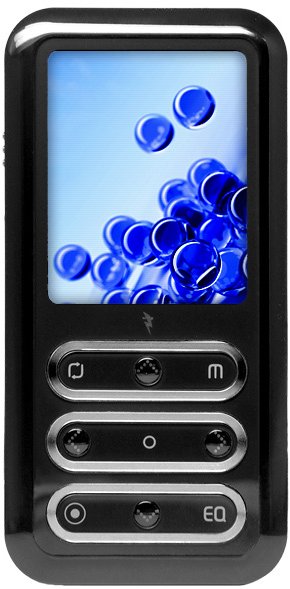Author: Lee Schlesinger
Turbolinux’s Linux-based wizpy music player is a beautiful device. It’s slick, black, and slightly smaller than the smallest cell phones. Unfortunately, its value and functionality doesn’t live up to its good looks.
Wizpy is available only in a 4GB model in the US. Its internal hard memory is divided into two partitions. An 8MB Turbolinux partition lets you boot your computer into Turbolinux from the device. The remaining space supports its music player functions; of that, only about 2.4GB is free for music files.
Wizpy charges its lithium polymer battery using power from a USB cable. The USB port at the bottom of the device is covered by a tiny cover with a plastic hinge that I suspect won’t last as long as the rest of the player. If you leave the player on pause for a configurable length of time that defaults to three minutes, wizpy will turn off to conserve power. From the time you press the power button until you see a menu is about 13 seconds — an eternity compared to some other MP3 players.

You don’t need any special software running on your host computer to sync your wizpy. When you plug it in to a Linux or Windows PC, it’s recognized as a USB storage device, and you can just drag and drop files to any of its directories. The device plays Ogg, MP3, and Windows Media Audio music formats, but it wouldn’t recognize an M4A file I tried to play. Sound quality is excellent.
The front panel controls, arranged in three rows of three buttons each, are mostly intuitive. In addition to five buttons for navigation and selection, there are buttons to bring up a menu, an equalizer, and a recording application for voice notes. The ninth button lets you mark beginning and end points in your music files that you can loop between.
When a song is playing, the bright OLED screen displays the file name in a scrolling bar, along with a volume indicator, battery life icon, and a histogram for the built-in equalizer. It doesn’t display album art, though if you copy a JPEG image to the device, you can view it from the Image menu. Wizpy also plays any DivX-encoded videos you might transfer to it.
Wizpy also bundles an FM radio receiver. When I set it to autoscan for stations, it picked up only three in my area — far fewer than my car radio can pull in. You can also navigate to any FM frequency and save it as one of 20 presets on the device.
You can record voice notes for yourself, but wizpy won’t save notes shorter than 6 seconds. Recording quality is very clear, but the device echoes your voice in its headphones while you’re talking.
Wizpy even includes a text viewing application. Turbolinux calls it “ebook,” but that’s overstating the case. You can view plain text files that have an extension of .utf, but since the window is only 23 characters wide and 8 lines long, with no automatic word wrap, it’s not too useful.
It’s also a boot drive!
If the wizpy performed its primary function of playing music better, you’d think its ability to boot any PC into a Linux desktop was a marvelous addition.
When you use wizpy as a portable boot device, you boot a 2.6.19-5 kernel. The first time you boot, the system prompts you for a username and password and a root password. When you restart, you log in to a KDE desktop with Mozilla-based browser and email client, Skype VoIP client, OpenOffice.org, and Amarok music player. Unfortunately, on my system, ALSA failed to work, and any music I played with Amarok came out of the wizpy earbuds.
The device comes with a mini boot CD for systems that won’t boot using USB CD-ROM or USB-HDD, and two mini manuals of the same size. One manual covers booting from the device, while the other is a user’s manual for the music player.
If you go online in search of further information, you’ll seek in vain. Turbolinux has set up a wizpy Club site, but there’s not much there yet. Even if there were, a flaw in the registration page, which comes up when you boot from the wizpy and open Firefox for the first time, prevents you from registering. That might be just as well, as the site demands too much personal information from customers who want to register.
The documentation, both printed and at the wizpy Club site, could use work. The English is awkward, likely because it has been imperfectly translated from Japanese. In addition, some important information is missing from the manuals — such as how you’re supposed to transfer files to the device.
All in all, this first wizpy release is a disappointment. It’s not worth its 0 price tag as a music player; a 4GB iPod Nano, which is the competition to beat, is less, and a 4GB USB flash drive costs only about . However, for anyone who needs both a music player and a USB boot drive and wants to carry only one stylish device, or has an extensive collection of Ogg files, the wizpy provides an alternative.
Categories:
- Handheld Devices
- Graphics & Multimedia


